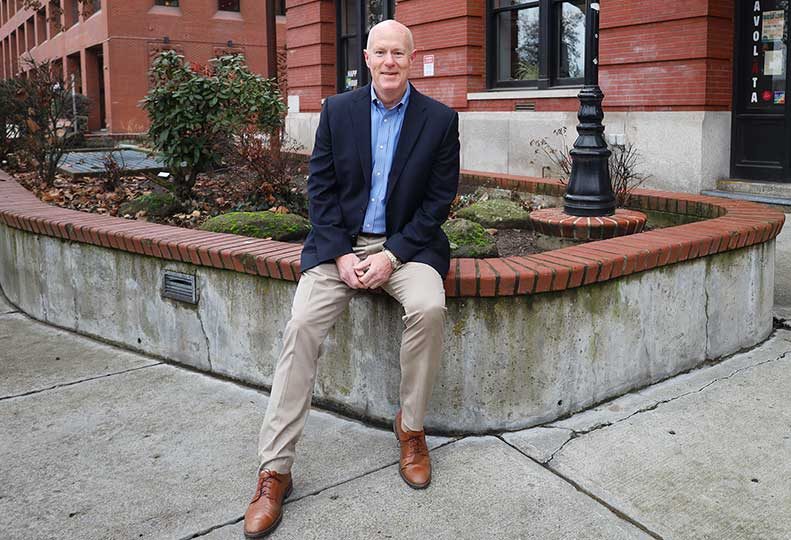
Home » Office pace: Class A vacancies approach 20% in the Central Business District
Office pace: Class A vacancies approach 20% in the Central Business District
Tenant mixes shift as hybrid work models, public safety influence market

Kiemle Hagood real estate broker Craig Soehren says Old City Hall is a prime example of an older property's successful redevelopment to attract and retain office tenants.
| Erica BullockFebruary 15, 2024
The downtown Spokane office market is adjusting to waning lease activity in the last five years, attributed to security concerns, parking expenses, and a hybrid workforce model, market experts here say.
Downtown Spokane office vacancy rates are nearing new highs, says Craig Soehren, real estate broker at Spokane-based Kiemle & Hagood Co.
Class A office vacancy rates are approaching 20% in the central business district, says Soehren. That's up from 18.19% for Class A office space in the fourth quarter of 2022, according to the Spokane-Kootenai Real Estate Research Committee's Fall 2023 Real Estate Report.
In Q4 2019, the central business district had 141,500 square feet of vacant Class A office space, compared to 205,800 square feet of vacant space in Q4 2022, according data from the research committee's report.
This year, Travelers, a New York-based insurance company with a longtime presence in the Crescent Building downtown, plans to move into smaller offices in the River View Corporate Center, at 16201 E. Indiana, in Spokane Valley, says Soehren.
With the upcoming move, he says office vacancy rates will climb "well over 20%."
"I can't remember it ever being that high," Soehren adds.
Jim Orcutt, commercial real estate broker at Spokane-based NAI Black, says Spokane's office market could be worse if not for the constricted development environment for new office buildings downtown.
"We haven't had a lot of new construction, so the supply side hasn't really expanded to the same degree as a lot of those bigger markets," Orcutt says.
Strong demand for office space in the central business district will continue to be supported by building conversions that are replacing offices with apartments.
The Peyton Building, at 10 N. Post; the Chronicle Building, at 926 W. Sprague; and the former James S. Black building's conversion into the Marjorie Apartments, at 107 S. Howard, are a few examples of office buildings that have been or soon will be removed from downtown office inventory in favor of residential use, Soehren says.
Orcutt concurs and says, "You could make the argument that there was an oversupply of product in some of those bigger markets. Developers are more reluctant to spec office buildings because they're more expensive to own and operate. So we don't have the same dramatic increase in office vacancies that some of the bigger markets have, but we don't have a thriving office leasing climate."
Ryan Yahne, founding partner at Spokane law firm Piskel Yahne Kovarik PLLC, says current leasing activity favors tenants over landlords.
Yahne, who has mostly represented property owners and landlords in commercial lease negotiations over a 20-year career, adds that landlords have become more aggressive in trying to attract tenants and "have an appetite to provide tenant improvements."
The dynamics of real estate have changed, says Soehren. "The other thing that's changed is a landlord's willingness to put money into the building," he says. "What we'll see now is longer term leases so landlords can afford the tenant improvements."
The Old City Hall building, at 221 N. Wall, is an example of successful office redevelopment to retain tenants and attract new companies, both Soehren and Orcutt say.
"That ownership has reinvested significant amounts of money and created a nice, modern building with some old style," Soehren says. "They've been able to lease quite a bit of space to tenants from ... other buildings throughout the core, and they've even brought in a couple of tenants that were outside the core to come downtown."
Historically, companies leased downtown office space for proximity to clients, but now working downtown is a recruitment strategy for talent, Soehren explains. In a tight labor market, companies that occupy Class A properties likely will do better than businesses that occupy economical spaces downtown, he says.
While the current decline of lease activity could be a sign of trouble to come, for now, owners who adapt through tenant improvements and building security can expect their downtown Spokane office properties to remain in demand, Soehren contends.
"Most buildings that are well managed are spending significantly more dollars on security these days," he says.
Due to the current security, parking, and workforce conditions impacting downtown Spokane, Orcutt says some office tenants are slowly shifting away from the central business district, east to the cities of Spokane Valley and Liberty Lake.
"You have a similar quality of products in the core and in the periphery for Class A, Class B, and Class C," Orcutt says. "Office tenants can really have their pick, depending on where they want to go."
For smaller downtown businesses, upcoming vacancies are a mixed bag of activity, according to Orcutt and Soehren.
As leases expire this year, Orcutt says to expect some small, women-owned businesses to leave the core due to safety concerns.
"They can pull up a moving truck and move their two to 10 employees out of 2,000 square feet in three or four days," says Orcutt. "Those people will move, and a lot of them are moving."
On the other hand, small office tenants currently are upholding lease activity in the core as larger tenants downsize and free up space for multiple occupants.
"The real active part of the market has been tenants with under 5,000 or even 2,500 square feet," says Soehren. "That part of the market has been very active both here and elsewhere."
Another contributor to small business office vacancies are expensive parking fees downtown, says Yahne.
"It's fairly expensive to park down here, especially if you've got an office full of 20 people and want to provide parking like we do, but it's a factor that it's a little more expensive to work downtown," Yahne says.
Piskel Yahne Kovarik is relocating from the Fidelity Building, at 522 W. Riverside, to 10,000 square feet of office space in The M building, at 612 W. Main, in April, as previously reported in the Journal.
"We are moving to The M building with an eye toward a nice office in a central location that's attractive to hiring people," Yahne says.
Despite a less active market, Soehren says there are still companies that are drawn to the core, such as Morrison-Maierle Inc., a Helena, Montana-based engineering and consulting company that vacated the Rock Pointe Corporate Center in the north bank neighborhood and moved to the Liberty Building, at 203 N. Washington.
"They wanted to be downtown because of their business relationships with engineering and architectural and other firms of that ilk," explains Soehren.
Soehren, who has 40 years of experience as a broker and downtown office property manager, says historical ups and downs in the office sector indicate that the current market can "bounce back."
"(The future of downtown) may have a different look," says Soehren. "It may have different tenants or it may have a different mix of tenants than we're used to seeing downtown."
Latest News Real Estate & Construction Instagram
Related Articles
Related Products


![Brad head shot[1] web](https://www.spokanejournal.com/ext/resources/2025/03/10/thumb/Brad-Head-Shot[1]_web.jpg?1741642753)

